|
[Front Page] [Features] [Departments] [Society Home] [Subscribe]

Understanding the System of Botanical Plant Names
Bruce Wallace
When talking with some members of the Australian Plants Society recently, the subject of understanding botanical names
came up.
Their question was "What do all these names really mean ? "
To anyone who is new to plants, these botanical names can be very confusing, and difficult to pronounce and to remember. Just using the common name instead can lead to more confusion. You may use a common name to refer to one plant, while I may only know it by a different common name. By using the botanical name, we both know what plant is being discussed.
A good example of common name confusion is the eucalypt with the common name of Blue Gum. Now, do you mean the Sydney Blue Gum, the Victorian Blue Gum, the Tasmanian Blue Gum, or one of the dozen or so other eucalypts with the common name of Blue Gum. These are all different species, and only by using the botanical name can we be sure what we are talking about.
I know it seems as if the botanical names are always changing. This is because in the botanical world of plant naming, it is the person who first published a name and a description for a new plant who has the right to give the "correct" name to the plant.
Back in the days when Australian plants were being discovered by Europeans (Aborigines had discovered, named and found uses for these plants hundreds, perhaps thousands of years earlier), there was a lot of confusion. A huge amount of material was collected and most of it was sent back to England and Europe for identification. The long time delay in this process caused confusion, especially at a time when there was some prestige in being the first to name a new plant. Inevitably, mistakes were made.
In the mid-1980s, the Australian Government determined that all of the Australian flora was to be checked for identification correctness. The results have been published in a series of monumental books entitled "The Flora of Australia". This has been a massive ongoing project.
The Naming System
In 1753, Carl von Linne (= Linnaeus in Latin), a Swedish botanist, published a system of scientific plant names involving two parts. This system has been used world-wide since that time. The first name, always spelled with a capital first letter, is the genus or generic name. It may be in honour of a person, eg. Banksia after Sir Joseph Banks, or in reference to characteristics of the plant, eg. Callistemon. meaning "beautiful stamens" (Greek kallistos = "beautiful"). The second name (always spelled with a small first letter) is the species name, and may honour a person, or describe a feature of the plant, or identify the geographic region where it grows.
I liken the naming of plants to our own system of first name and surname, except that with plants, the names are in reverse, with the "surname" or genus name first, eg. Banksia, and with the "Christian name" or species name second, eg. ericifolia. Sometimes, an extra name is added, eg. Banksia ericifolia var. macrantha. The "var". is short for "variety", meaning there are taxonomic differences that make it distinct from the rest of the species.
At other times, we come across plant names with a genus name, eg. Viola, a species name, hederacea, and the extra name ssp. sieberiana. "ssp" or "sub-species" means there are differences in minor morphological character, such as in size or shape of the parts, due to growing in partial or complete isolation because of geographical or ecological barriers.
Let's illustrate this naming system by looking at some of the plants that grow on the Central Coast of New South Wales. The following list is a small sample, enough to illustrate the principles behind the apparently complex system of naming plants.
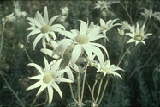
Actinotus helianthi

Banksia spinulosa
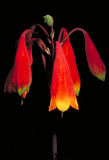
Blandfordia grandiflora

Clematis aristata
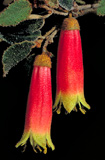
Correa reflexa
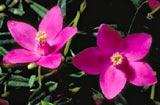
Crowea exalata
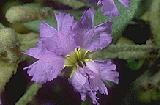
Dampiera purpurea
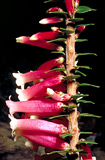
Epacris longiflora
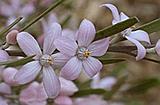
Eriostemon australasius

Lambertia formosa
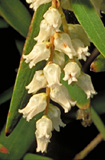
Leucopogon lanceolatus
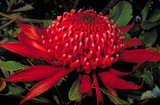
Telopea speciosissima
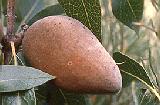
Xylomelum pyriforme (fruit)
Click on thumbnail images or plant names for larger images |
| Genus | Species Examples |
Actinotus
- From Greek actinos = like the spokes of a wheel, referring to the spreading bracts. | helianthi = similar to the genus Helianthus, the sunflower (common name "Flannel Flower) |
Allocasuarina
- From Greek allos = "other", indicating differences, alternatives or divergence from the genus Casuarina. | torulosa = slightly uneven, from Latin torulus, meaning little bumps (on the cones).
distyla = "with two styles". |
Angophora
- From Greek angon = "jar", and pharos = "bearing", referring to the cup-shaped fruits. | hispida = covered with coarse, erect hairs. |
Banksia
- After Sir Joseph Banks. | ericifolia = having leaves like the genus Erica.
robur = having leaves like the English oak-tree Quercus robur.
spinulosa = bearing small spines.
marginata = with a margin round the edge of the leaves.
integrifolia = with leaves "entire", ie. not toothed or indented. |
Blandfordia
- After George Spencer Churchill, Marquis of Blandford, 19th century flower lover. | grandiflora = having large flowers (common name "Christmas Bells"). |
Boronia
- After Francesco Borone, 18th century Italian botanist. | ledifolia = with leaves resembling the genus Ledum.
serrulata = with fine teeth along the margin of the leaves (cf "serrated"). |
Brachyloma
- From Greek brachys = short and loma = edge or fringe. This alludes to the hairs or scales in the throat of the corolla tube. | daphnoides = similar to the genus Daphne, a reference to its perfume. |
Callistemon
- From Greek callos = "beauty" and stamon = "a stamen". | citrinus = "lemon-scented".
salignus = "willow-like", from Latin salyx. |
Casuarina
- Resembling the drooping feathers of the Cassowary. | glauca = grey-coloured. |
Ceratopetalum
- From Greek ceras = horn, petalon = a petal. One species has a petal resembling a stag's horn. | apetalum = without petals (common name, "Coachwood").
gummiferum = yielding gum (common name "NSW Christmas Bush"). |
Clematis
- From Greek clema = a vine shoot. Clematis is a general name for a climber. | glycinoides = like the genus Glycine.
aristata = Latin for "a bristle", referring to a hair-like appendage on the anthers. |
Correa
- After Jose Francisco Correa de Serra, 18-19th century Portuguese botanist. | alba = Latin for "white".
lawrenciana = named after R W Lawrence, an early Tasmanian botanist.
reflexa = "sharply turned back'', referring to the flowers. |
Crowea
- After James Crowe, 18th century English surgeon and plant enthusiast. | exalata = without wings (on the flowers). |
Dampiera
- After William Dampier, 17-18h century English navigator and explorer. | purpurea = purple. |
Darwinia
- After Erasmus Darwin 1731-1800, grandfather of Charles Darwin. | fascicularis = Latin for "in bundles or clusters". |
Doryanthes
- From Greek dory = spear, and anthos = a flower, referring to the long flower stem. | excelsa = Latin for "tall" or "exceptional" (common name "Gymea Lily"). |
Epacris
- From Greek epi = upon and akros = a summit, referring to the elevated habitats of some species. | longiflora = having long flowers.
pulchella = Latin "beautiful".
microphylla = having small leaves.
obtusifolia = having blunt leaves (ie. without a pointed tip). |
Eriostemon
- From Greek erion = wool and stemon = stamen. | australasius = from Australia. |
Eucalyptus
- From Greek eu = "well, completely "and kalyptos = "covered", referring to the flower buds, in particular, the cap or operculum, covering the bud. | haemastoma = Greek for "with a blood-red throat".
botryoides = Greek for "clustered like a bunch of grapes", referring to the fruits. |
Grevillea
- After Charles F. Greviile, 18-19th century co-founder of what is now the Royal Horticultural Society. | buxifolia = with leaves like the box tree Buxus.
speciosa = Latin for "showy" or "handsome".
sericea = Latin for "silky".
shiressii = named after D W D Shiress, 20th century collector.
linearifolia = leaves in a linear shape, ie. straight. |
Isopogon
- From Greek isos = "equal" and pogon = "beard", referring to the hairs on the fruit. | anemonifolius = with leaves similar to the genus Anemone.
anethifolius = with leaves similar to the genus Anethum, the common herb "Dill". |
Lambertia
- After Aylmer B Lambert, an 18-19th century English patron of botany. | formosa = Latin for "beautiful" (common name "Mountain Devil"). |
Leucopogon
- From Greek leucos = white and pogon = beard, referring to the white bearded corolla lobes. | amplexicaulis = Latin for "stem-clasping".
lanceolatus = having lance-shaped leaves
parviflorus = having small flowers. |
Lomatia
- From Greek loma = border or fringe, referring to the papery wing surrounding the seed. | silaifolia = from Latin silai meaning "finely cut leaf" similar to Silaum. |
Prostanthera
- From Greek prostheke = "an appendix", and anthera = an anther. | incisa = Latin for "cut", referring to the toothed leaves.
rhombea = leaves shaped like a rhomboid. |
Telopea
- From Greek telopos = "seen from afar", referring to the conspicuous flowers. | speciosissima = Latin for "most beautiful" (common name "NSW Waratah"). |
Xylomelum
- From Greek xylon = wood, and melon = a fruit free, referring to the large woody fruit. | pyriforme = Latin for "pear-shaped", after the shape of the fruit. |
|
From the newsletter of the Central Coast group of the Australian Plants Society (NSW), 2001.

[Front Page] [Features] [Departments] [Society Home] [Subscribe]
Australian Plants online - September 2002
Association of Societies for Growing Australian Plants
|